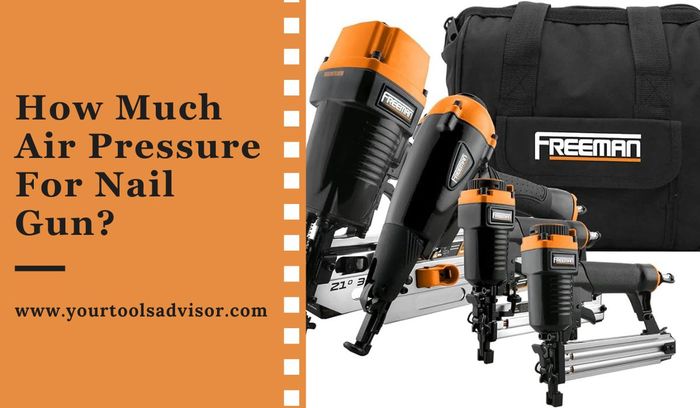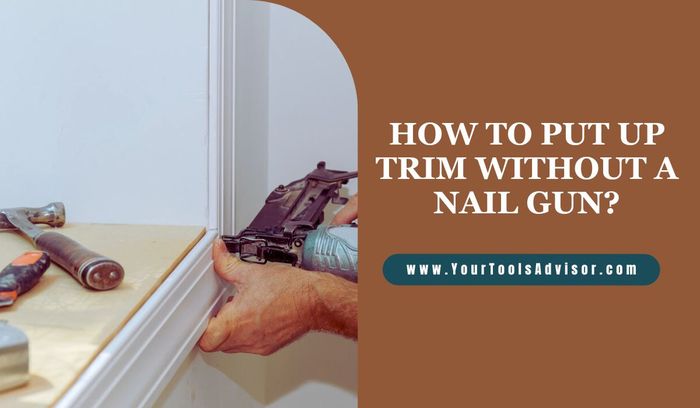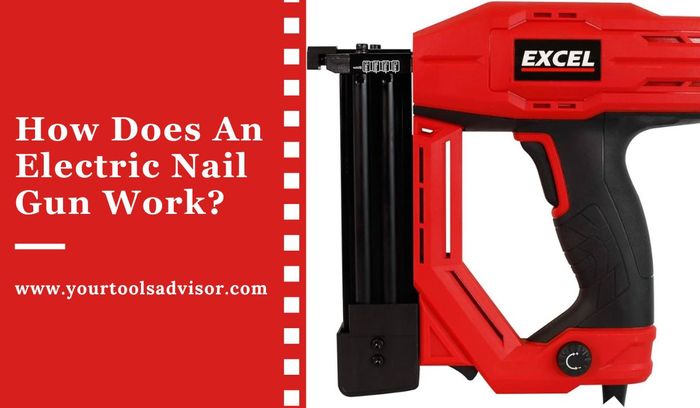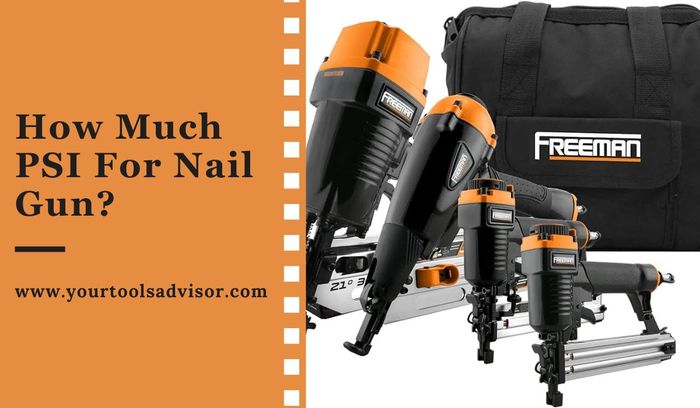In the realm of construction and woodworking, efficiency is paramount, and tools that can streamline the building process are invaluable. One such marvel of modern engineering is the nail gun.
Whether you’re a seasoned carpenter or a DIY enthusiast, understanding the inner workings of this powerful tool can deepen your appreciation for its speed and precision.
Nail guns are commonly used in construction, carpentry, and other industries where large quantities of nails need to be driven in quickly and accurately. The speed and force of the piston ensure that the nail is driven in securely and quickly, making the process of nailing much faster and more efficient compared to using a hammer.
So, how does a nail gun work?…
Well, a nail gun works by using compressed air or electromagnetism to drive nails into wood or other materials. The gun is loaded with nails, and when the trigger is pulled, a piston is pushed forward, forcing the nail into the surface.
In our exploration today, we’ll dissect the intricate mechanisms that power a nail gun and delve into the science behind its ability to drive nails effortlessly into various materials.
From pneumatic systems to gas-powered mechanisms, each type of nail gun boasts its unique set of features designed to make your projects not only faster but also more precise.
So, buckle up as we embark on a journey to unravel the mysteries of how a nail gun works and discover the fascinating technology that revolutionized the world of construction.
Basics Of Nail Guns
Nail guns are crucial tools in the construction industry, making the process of fastening nails much more efficient. The basics of how a nail gun works involve a combination of compressed air or electromagnetism to propel nails into different materials.
There are various types of nail guns available, each designed for specific tasks and materials. These include framing nail guns, brad nailers, finish nailers, and roofing nail guns. Framing nail guns are commonly used for heavy-duty tasks like framing walls and installing subfloors.
Brad nailers, on the other hand, are ideal for lighter projects like trim work and cabinet installation. Finish nailers are perfect for furniture building and molding, while roofing nail guns are specifically designed for shingle installation.
Understanding different types of nail guns is essential for choosing the right tool for any construction project.
Components Of A Nail Gun
A nail gun operates using a combination of key components. The first component is the power source, which can be pneumatic, electric, or cordless. The power source determines the portability and strength of the nail gun. Another important component is the magazine, where nails are loaded and selected.
The magazine holds the nails in place and allows for easy access. The trigger mechanism is responsible for firing the nails and can be either single-sequential or contact. The single-sequential trigger requires two steps to fire a nail, while the contact trigger fires nails when the trigger is held down.
Safety features are also crucial and can include anti-dry fire protection and depth adjustment settings. These ensure safe and accurate nail placement.
Overall, a nail gun consists of these components that work together to make construction and woodworking projects more efficient and convenient.
How Does A Nail Gun Work?
A nail gun operates through a simple yet efficient working mechanism.
Firstly, the nail loading and chamber preparation take place. Then, the compression of air or energy source occurs. After that, the trigger gets activated, resulting in the firing of the nail. Finally, the nail gun resets, ready for the next nail. This sequential process ensures smooth and precise nailing.
The nail gun revolutionized the construction industry, making it easier and faster to complete various projects. The modern nail guns are designed to improve productivity while reducing the effort and time required for traditional hammering.
These tools are widely used in construction, woodworking, and DIY projects, offering convenience and accuracy in driving nails efficiently. With different types and sizes available, nail guns provide versatility to cater to different needs and requirements.
Overall, a nail gun is an indispensable device for professionals and DIY enthusiasts alike, making construction tasks more efficient and convenient.
Advantages And Limitations Of Nail Guns
Nail guns are efficient tools that offer speedy and precise nail placement. These tools reduce physical strain and fatigue for users, improving overall productivity.
However, it is important to be aware of potential hazards and safety considerations when using a nail gun.
Safety precautions, such as wearing appropriate protective gear, following proper procedures, and maintaining the tool’s condition, should be prioritized to prevent accidents and injuries. By using a nail gun correctly and responsibly, one can maximize its advantages while minimizing risks.
With increased efficiency, reduced physical strain, and proper safety measures, nail guns provide a convenient solution for various construction and woodworking tasks.
So, it is crucial to understand the working mechanism, advantages, and limitations of nail guns to utilize them effectively and safely in any project.
Common Uses Of Nail Guns
Nail guns are powerful tools used for a variety of applications, such as framing and carpentry. They make the process quicker and more efficient by easily driving nails into various materials.
In framing and carpentry, nail guns are essential for assembling wood structures, like walls and decks. Upholstery and furniture assembly are also common uses of nail guns, enabling quick and secure attachment of upholstery fabric and assembly of furniture pieces.
Furthermore, nail guns are highly effective for flooring and roofing installations. They allow for precise and rapid insertion of nails, ensuring proper attachment of flooring materials and shingles.
Overall, nail guns are indispensable in the construction industry, streamlining processes and enhancing productivity.
Maintenance And Safety Tips
A nail gun works by utilizing compressed air to drive nails into various materials. To ensure its proper functioning, regular cleaning and lubrication are crucial. This involves removing any debris or dust particles that may accumulate inside the gun.
Additionally, proper handling and storage are important to prevent any damage or accidents. It is essential to wear eye and ear protection while using the nail gun, as it generates loud noises and may cause flying debris.
Adhering to usage guidelines is also imperative, such as angling the gun correctly and holding it firmly against the surface.
By following these maintenance and safety tips, users can ensure the efficient and safe operation of a nail gun during their various projects.
FAQs About How Does A Nail Gun Work
How Do Air Powered Nail Guns Work?
Air powered nail guns work by using compressed air to drive nails into various materials. The process is simple: when you press the trigger, compressed air stored in a tank is released, pushing a piston forward. The piston then drives the nail into the work surface with great force.
This method allows for rapid and efficient nailing, making it a popular choice among professionals and DIY enthusiasts alike. The compressed air is stored in a separate chamber connected to the nail gun, and it is replenished by an air compressor. The nail guns are available in different sizes and types, catering to specific needs and requirements.
Overall, air powered nail guns offer a fast and powerful solution for nailing tasks, reducing the effort and time required compared to traditional manual methods.
How does an electric nail gun work?
An electric nail gun operates by utilizing electricity to power a motor that drives a piston mechanism. When the trigger is pressed, the motor activates, pushing the piston rapidly, which in turn propels a nail into the material. This process is efficient and quick, making it a popular tool in construction and woodworking for its speed and ease of use.
How Does A Propane Nail Gun Work?
A propane nail gun runs on the power of a small internal combustion engine. When the trigger is squeezed, it activates a spark plug that ignites the propane and air mixture. This produces a controlled explosion that drives a piston forward.
The piston, in turn, pushes a nail into the material. The process repeats quickly, allowing for fast and efficient nailing. Propane is preferred over other fuel sources due to its clean burning properties and portability. It offers consistent power and doesn’t require cords or external power sources.
Propane nail guns are commonly used in construction projects as they are easy to handle and provide reliable performance.
What are nail guns powered by?
Nail guns are typically powered by compressed air, electricity, or gas. Pneumatic nail guns use compressed air from an external source, while electric models rely on electricity for operation. Gas-powered nail guns utilize a fuel cell or canister for power.
Do nail guns use air?
Yes, nail guns can use air as a power source. Pneumatic nail guns are common and operate by utilizing compressed air to drive nails into various surfaces. Additionally, there are also electric and gas-powered nail guns available that offer alternative sources of power.
Conclusion
In conclusion, understanding how a nail gun works unveils the fascinating mechanics behind this essential tool in construction and woodworking.
From the trigger to the piston, each component plays a crucial role in driving nails effortlessly and efficiently into various surfaces. The evolution of nail gun technology has not only increased productivity but also enhanced safety and precision in the construction industry.
As we’ve explored, the pneumatic, electric, and gas-powered nail guns each have their unique advantages, catering to different needs and preferences.
Whether you’re a professional carpenter or a DIY enthusiast, having a good grasp of the inner workings of a nail gun empowers you to make informed choices, ensuring the right tool for the job.
As technology continues to advance, we can anticipate further innovations in nail gun design and functionality. Perhaps we’ll witness the emergence of even more user-friendly and versatile models, further revolutionizing the way we approach woodworking and construction projects.
In the end, the humble nail gun might seem like a simple device, but its intricate design showcases the marriage of engineering brilliance and practical functionality.
Armed with the knowledge of how a nail gun operates, you’re not just wielding a tool – you’re harnessing the power of precision and efficiency to bring your creative and constructive visions to life.





Leave a Reply